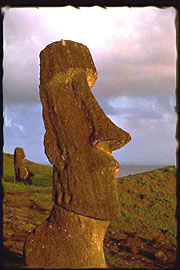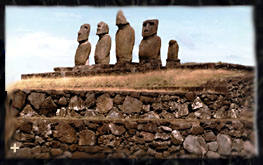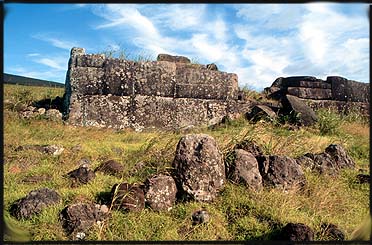

|
 Once
the statues were reasonably complete they then had to be transported across
the island to the platforms prepared for them. This involved a trek of
14 miles in some cases. How were these massive Moai moved to the sites?
Barring any extraterrestrial influence it seems likely that they were rolled
along the ancient roads that crisscrossed the island on logs lubricated
with the oils from palm trees. Some suggest that they were moved in an
upright position and kept stable by crews manning ropes. This mode would
verify the islands legends of the statues "walking" to their sites. From
a distance seeing one of these great Moai moving along the road bobbing
up and down as the logs moved underneath would surely have looked like
statue moving under its own power with a procession along side it. What
a sight that would have been. Once
the statues were reasonably complete they then had to be transported across
the island to the platforms prepared for them. This involved a trek of
14 miles in some cases. How were these massive Moai moved to the sites?
Barring any extraterrestrial influence it seems likely that they were rolled
along the ancient roads that crisscrossed the island on logs lubricated
with the oils from palm trees. Some suggest that they were moved in an
upright position and kept stable by crews manning ropes. This mode would
verify the islands legends of the statues "walking" to their sites. From
a distance seeing one of these great Moai moving along the road bobbing
up and down as the logs moved underneath would surely have looked like
statue moving under its own power with a procession along side it. What
a sight that would have been.
Recent
computer simulations, however, by Jo Anne Van Tilburg at UCLA, have shown
that it would have been much simpler to position the Moai in a horizontal
position on two large logs and then roll the whole unit along on other
logs placed perpendicular to it. Using this method Van Tilburg calculated
that an average moai could have been moved from the quarry to Ahu Akivi
in less than 5 days, using approximately 70 men. Her theories were recently
put to the test in a successful experiment to move a moai replica on Easter
Island sponsored and filmed by Nova (see resources section) |
| Once
the journey was complete the Moai were positioned atop great platforms
called Ahu. Built at the edge of the ocean, the Ahu required just as much
engineering know-how and raw labor as the statue construction itself. It
is here that the Easter Islanders' stonework skills can fully be appreciated.
As seen in the images to the right of Ahu Naunau and Ahu Tahai, massive
blocks and tons of fill were required to build the supports for the moai.
Although they were an incredible engineering feat, most of the ahu build
were less than elegant constructions. At one mysterious site however, it
was much different. |
 |
 To
the right is Ahu Vai Uri, compare the stonework of it to the image below
at Ahu Vinapu, on the southern shore near Rano Kau. In the detail shot
you can see the incredible precision in the stone fittings. It was this
precision, so similar to the stonework done by the Incas, that gave Thor
Heyerdahl the idea that the Easter Islanders had come from South America
in reed boats on the prevailing currents. Stonework of this complexity
had not been seen in Polynesia, but it was common in Peru. It's impossible
to look at that site and not think of the exact type of stone fitting which
is so common in sites like Machu Picchu. Most archaeologists consider the
similarities a coincidence. If so it is a remarkable one. To
the right is Ahu Vai Uri, compare the stonework of it to the image below
at Ahu Vinapu, on the southern shore near Rano Kau. In the detail shot
you can see the incredible precision in the stone fittings. It was this
precision, so similar to the stonework done by the Incas, that gave Thor
Heyerdahl the idea that the Easter Islanders had come from South America
in reed boats on the prevailing currents. Stonework of this complexity
had not been seen in Polynesia, but it was common in Peru. It's impossible
to look at that site and not think of the exact type of stone fitting which
is so common in sites like Machu Picchu. Most archaeologists consider the
similarities a coincidence. If so it is a remarkable one. |

Ahu
Vinapu (top) click fordetail of wall
|
| Soon
ahu with erected moai were installed on all corners of the island. Over
one thousand moai had been carved. For years the competition to build the
biggest and the best Moai went on. The population of the island continued
to grow. Different ahu, each belonging to a different clan, formed an almost
unbroken line along the coast of Easter Island. The culture had reached
it's peak. And, then something went terribly wrong.... |
  |
 |
©2000 Myths & Mysteries of the World
All rights reserved. Unauthorized copying and manipulation is prohibited. |
![]()
